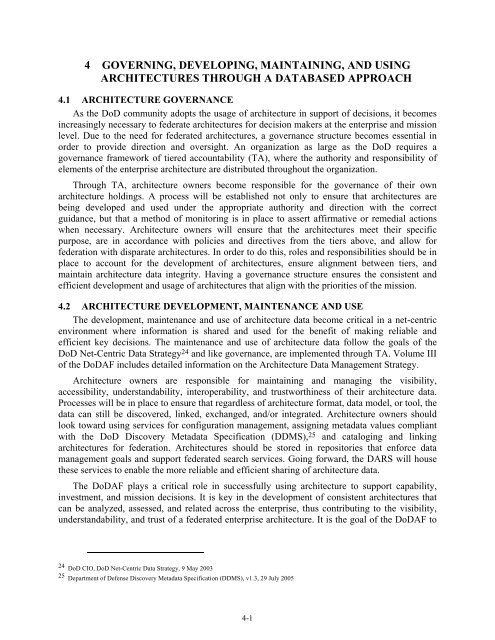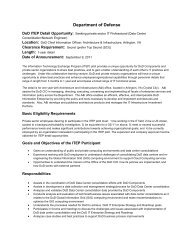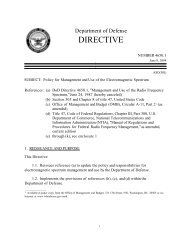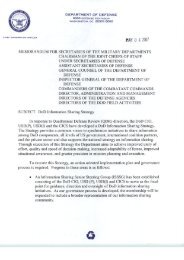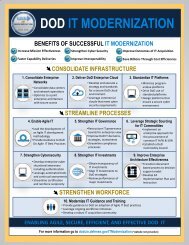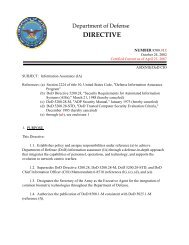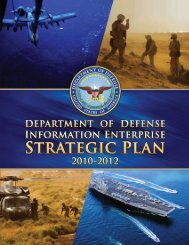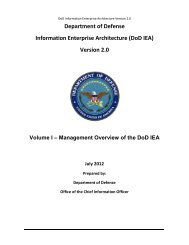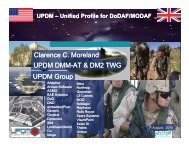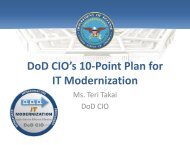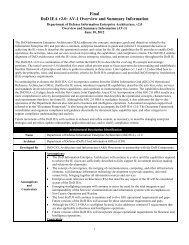DoD Architecture Framework Version 1.5 - Chief Information Officer
DoD Architecture Framework Version 1.5 - Chief Information Officer
DoD Architecture Framework Version 1.5 - Chief Information Officer
Create successful ePaper yourself
Turn your PDF publications into a flip-book with our unique Google optimized e-Paper software.
4 GOVERNING, DEVELOPING, MAINTAINING, AND USING<br />
ARCHITECTURES THROUGH A DATABASED APPROACH<br />
4.1 ARCHITECTURE GOVERNANCE<br />
As the <strong>DoD</strong> community adopts the usage of architecture in support of decisions, it becomes<br />
increasingly necessary to federate architectures for decision makers at the enterprise and mission<br />
level. Due to the need for federated architectures, a governance structure becomes essential in<br />
order to provide direction and oversight. An organization as large as the <strong>DoD</strong> requires a<br />
governance framework of tiered accountability (TA), where the authority and responsibility of<br />
elements of the enterprise architecture are distributed throughout the organization.<br />
Through TA, architecture owners become responsible for the governance of their own<br />
architecture holdings. A process will be established not only to ensure that architectures are<br />
being developed and used under the appropriate authority and direction with the correct<br />
guidance, but that a method of monitoring is in place to assert affirmative or remedial actions<br />
when necessary. <strong>Architecture</strong> owners will ensure that the architectures meet their specific<br />
purpose, are in accordance with policies and directives from the tiers above, and allow for<br />
federation with disparate architectures. In order to do this, roles and responsibilities should be in<br />
place to account for the development of architectures, ensure alignment between tiers, and<br />
maintain architecture data integrity. Having a governance structure ensures the consistent and<br />
efficient development and usage of architectures that align with the priorities of the mission.<br />
4.2 ARCHITECTURE DEVELOPMENT, MAINTENANCE AND USE<br />
The development, maintenance and use of architecture data become critical in a net-centric<br />
environment where information is shared and used for the benefit of making reliable and<br />
efficient key decisions. The maintenance and use of architecture data follow the goals of the<br />
<strong>DoD</strong> Net-Centric Data Strategy 24 and like governance, are implemented through TA. Volume III<br />
of the <strong>DoD</strong>AF includes detailed information on the <strong>Architecture</strong> Data Management Strategy.<br />
<strong>Architecture</strong> owners are responsible for maintaining and managing the visibility,<br />
accessibility, understandability, interoperability, and trustworthiness of their architecture data.<br />
Processes will be in place to ensure that regardless of architecture format, data model, or tool, the<br />
data can still be discovered, linked, exchanged, and/or integrated. <strong>Architecture</strong> owners should<br />
look toward using services for configuration management, assigning metadata values compliant<br />
with the <strong>DoD</strong> Discovery Metadata Specification (DDMS), 25 and cataloging and linking<br />
architectures for federation. <strong>Architecture</strong>s should be stored in repositories that enforce data<br />
management goals and support federated search services. Going forward, the DARS will house<br />
these services to enable the more reliable and efficient sharing of architecture data.<br />
The <strong>DoD</strong>AF plays a critical role in successfully using architecture to support capability,<br />
investment, and mission decisions. It is key in the development of consistent architectures that<br />
can be analyzed, assessed, and related across the enterprise, thus contributing to the visibility,<br />
understandability, and trust of a federated enterprise architecture. It is the goal of the <strong>DoD</strong>AF to<br />
24 <strong>DoD</strong> CIO, <strong>DoD</strong> Net-Centric Data Strategy, 9 May 2003<br />
25 Department of Defense Discovery Metadata Specification (DDMS), v1.3, 29 July 2005<br />
4-1


